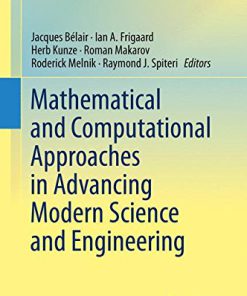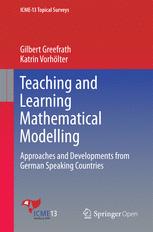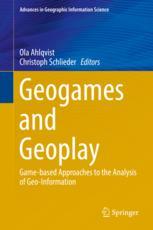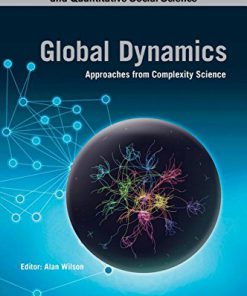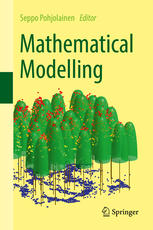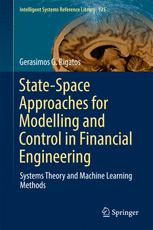Approaches to Geo mathematical Modelling New Tools for Complexity Science 1st Edition by Alan Wilson 1118937440 9781118937440
$50.00 Original price was: $50.00.$25.00Current price is: $25.00.
Approaches to Geo mathematical Modelling New Tools for Complexity Science 1st Edition by Alan G. Wilson – Ebook PDF Instant Download/DeliveryISBN: 1118937440, 9781118937440
Full download Approaches to Geo mathematical Modelling New Tools for Complexity Science 1st Edition after payment.
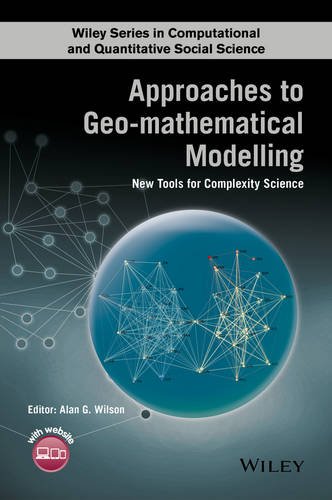
Product details:
ISBN-10 : 1118937440
ISBN-13 : 9781118937440
Author: Alan G. Wilson
Geo-mathematical modelling: models from complexity science Sir Alan Wilson, Centre for Advanced Spatial Analysis, University College London Mathematical and computer models for a complexity science tool kit Geographical systems are characterised by locations, activities at locations, interactions between them and the infrastructures that carry these activities and flows. They can be described at a great variety of scales, from individuals and organisations to countries. Our understanding, often partial, of these entities, and in many cases this understanding is represented in theories and associated mathematical models. In this book, the main examples are models that represent elements of the global system covering such topics as trade, migration, security and development aid together with examples at finer scales. This provides an effective toolkit that can not only be applied to global systems, but more widely in the modelling of complex systems. All complex systems involve nonlinearities involving path dependence and the possibility of phase changes and this makes the mathematical aspects particularly interesting. It is through these mechanisms that new structures can be seen to ‘emerge’, and hence the current notion of ‘emergent behaviour’. The range of models demonstrated include account-based models and biproportional fitting, structural dynamics, space-time statistical analysis, real-time response models, Lotka-Volterra models representing ‘war’, agent-based models, epidemiology and reaction-diffusion approaches, game theory, network models and finally, integrated models.
Approaches to Geo mathematical Modelling New Tools for Complexity Science 1st Table of contents:
Part One: Approaches
Chapter 1: The Toolkit
Part Two: Estimating Missing Data: Bi-proportional Fitting and Principal Components Analysis
Chapter 2: The Effects of Economic and Labour Market Inequalities on Interregional Migration in Europe
2.1 Introduction
2.2 The Approach
2.3 Data
2.4 Preliminary Analysis
2.5 Multinomial Logit Regression Analysis
2.6 Discussion
2.7 Conclusions
References
Chapter 3: Test of Bi-Proportional Fitting Procedure Applied to International Trade
3.1 Introduction
3.2 Model
3.3 Notes of Implementation
3.4 Results
References
Chapter 4: Estimating Services Flows
4.1 Introduction
4.2 Estimation Via Iterative Proportional Fitting
4.3 Estimating Services Flows Using Commodities Flows
4.4 A Comparison of The Methods
4.5 Results
4.6 Conclusion
References
Chapter 5: A Method for Estimating Unknown National Input–Output Tables Using Limited Data
5.1 Motivation and Aims
5.2 Obstacles to The Estimation of National Input–Output Tables
5.3 Vector Representation of Input–Output Tables
5.4 Method
5.5 In-Sample Assessment of The Estimates
5.6 Out-of-Sample Discussion of The Estimates
5.7 Conclusion
References
Part Three: Dynamics in Account-based Models
Chapter 6: A Dynamic Global Trade Model With Four Sectors: Food, Natural Resources, Manufactured Goods and Labour
6.1 Introduction
6.2 Definition of Variables for System Description
6.3 The Pricing and Trade Flows Algorithm
6.4 Initial Setup
6.5 The Algorithm to Determine Farming Trade Flows
6.6 The Algorithm to Determine The Natural Resources Trade Flows
6.7 The Algorithm to Determine Manufacturing Trade Flows
6.8 The Dynamics
6.9 Experimental Results
References
Chapter 7: Global Dynamical Input–Output Modelling
7.1 Towards a Fully Dynamic Inter-country Input–Output Model
7.2 National Accounts
7.3 The Dynamical International Model
7.4 Investment: Modelling Production Capacity: The Capacity Planning Model
7.5 Modelling Production Capacity: The Investment Growth Approach
7.6 Conclusions
References
Appendix
A.1 Proof of Linearity of the Static Model and the Equivalence of Two Modelling Approaches
Part Four: Space-Time Statistical Analysis
Chapter 8: Space–Time Analysis of Point Patterns in Crime and Security Events
8.1 Introduction
8.2 Application in Novel Areas
8.3 Motif Analysis
8.4 Discussion
References
Part Five: Real-Time Response Models
Chapter 9: The London Riots – 1: Epidemiology, Spatial Interaction and Probability of Arrest
9.1 Introduction
9.2 Characteristics of Disorder
9.3 The Model
9.4 Demonstration Case
9.5 Concluding Comments
References
Appendix
A.1 Note on Methods: Data
A.2 Numerical Simulations
Chapter 10: The London Riots – 2: A Discrete Choice Model
10.1 Introduction
10.2 Model Setup
10.3 Modelling the Observed Utility
10.4 Results
10.5 Simulating the 2011 London Riots: Towards a Policy Tool
10.6 Modelling Optimal Police Deployment
References
Part Six: The Mathematics of War
Chapter 11: Richardson Models with Space
11.1 Introduction
11.2 The Richardson Model
11.3 Empirical Applications of Richardson’s Model
11.4 A Global Arms Race Model
11.5 Relationship to a Spatial Conflict Model
11.6 An Empirical Application
11.7 Conclusion
References
Part Seven: Agent-Based Models
Chapter 12: Agent-based Models of Piracy
12.1 Introduction
12.2 Data
12.3 An Agent-based Model
12.4 Model Calibration
12.5 Discussion
References
Chapter 13: A Simple Approach for the Prediction of Extinction Events in Multi-agent Models
13.1 Introduction
13.2 Key Concepts
13.3 The NANIA Predator–prey Model
13.4 Computer Simulation
13.5 Period Detection
13.6 A Monte Carlo Approach to Prediction
13.7 Conclusions
References
Part Eight: Diffusion Models
Chapter 14: Urban Agglomeration Through the Diffusion of Investment Impacts
14.1 Introduction
14.2 The Model
14.3 Mathematical Analysis for Agglomeration Conditions
14.4 Simulation Results
14.5 Conclusions
References
Part Nine: Game Theory
Chapter 15: From Colonel Blotto to Field Marshall Blotto
15.1 Introduction
15.2 The Colonel Blotto Game and its Extensions
15.3 Incorporating a Spatial Interaction Model of Threat
15.4 Two-front Battles
15.5 Comparing Even and Uneven Allocations in a Scenario with Five Fronts
15.6 Conclusion
References
Chapter 16: Modelling Strategic Interactions in a Global Context
16.1 Introduction
16.2 The Theoretical Model
16.3 Strategic Estimation
16.4 International Sources of Uncertainty in the Context of Repression and Rebellion
16.5 International Sources of Uncertainty Related to Outcomes
16.6 Empirical Analysis
16.7 Results
16.8 Additional Considerations Related to International Uncertainty
16.9 Conclusion
References
Chapter 17: A General Framework for Static, Spatially Explicit Games of Search and Concealment
17.1 Introduction
17.2 Game Theoretic Concepts
17.3 Games of Search and Security: A Review
17.4 The Static Spatial Search Game (SSSG)
17.5 The Graph Search Game (GSG)
17.6 Summary and Conclusions
References
Part Ten: Networks
Chapter 18: Network Evolution: A Transport Example
18.1 Introduction
18.2 A Hierarchical Retail Structure Model as a Building Block
18.3 Extensions to Transport Networks
18.4 An Application in Transport Planning
18.5 A Case Study: Bagnoli in Naples
18.6 Conclusion
References
Chapter 19: The Structure of Global Transportation Networks
19.1 Introduction
19.2 Method
19.3 Analysis of the European Map
19.4 Towards a Global Spatial Economic Map: Economic Analysis by Country
19.5 An East-west Divide and Natural Economic Behaviour
19.6 Conclusion
References
Chapter 20: Trade Networks and Optimal Consumption
20.1 Introduction
20.2 The Global Economic Model
20.3 Perturbing Final Demand Vectors
20.4 Analysis
20.5 Conclusions
Acknowledgements
References
Appendix
Part Eleven: Integration
Chapter 21: Research Priorities
People also search for Approaches to Geo mathematical Modelling New Tools for Complexity Science 1st:
a geometric approach to differential forms
a mathematical process for transferring locations
geometric approach to differential forms pdf
economic mathematical models
forecasting mathematical models
Tags: Approaches, Geo mathematical, Modelling, New Tools, Complexity Science, Alan Wilson
You may also like…
Medicine - Dermatology
Computers - Computer Science
Education Studies & Teaching
Science (General)
Mathematics
Education Studies & Teaching - Education - General & Miscellaneous
Computers - Programming
Computers - Computer Science





